Warning! This report contains graphic videos and images that may not be suitable for younger readers and may be disturbing for adults.
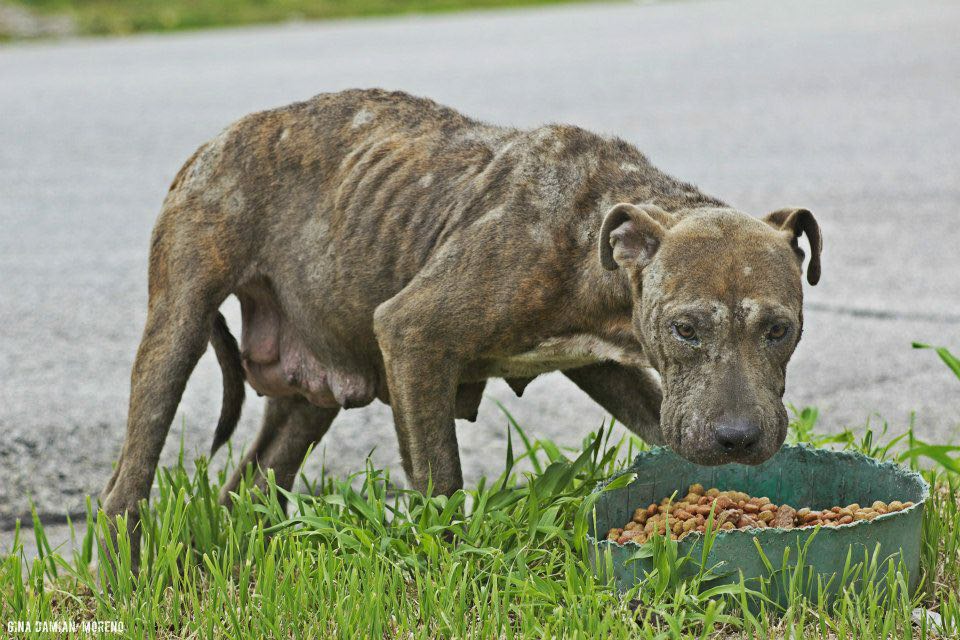
Photo by Gina Damian
By
Richard C. Vara

March 5, 2023
HOUSTON- Nicole Acevedo and her husband have spent every night for the past five years driving through the neighborhood of Cloverleaf in search of stray animals. They are never disappointed by a lack of strays in their search efforts. Within the first three stops they encounter upwards of 50 stray dogs and cats. Some of the dogs are very excited to see them and wag their tails in anticipation. The Acevedo dark grey SUV is filled with large bags and cans of dog food. For some of these poor creatures, this is the only meal they might receive for the day. For others, it is more obvious that this is the first time they have eaten in days.
An estimated 1 million stray dogs are living on the streets of the “Space City,” according to BARC, the city’s animal control department. The population of stray dogs in Houston outnumbers the human population of Austin, Forth Worth, and El Paso. These three cities are in the top ten most populated cities in Texas. Houston is the largest city in the “Lone Star” state and fourth in the nation.
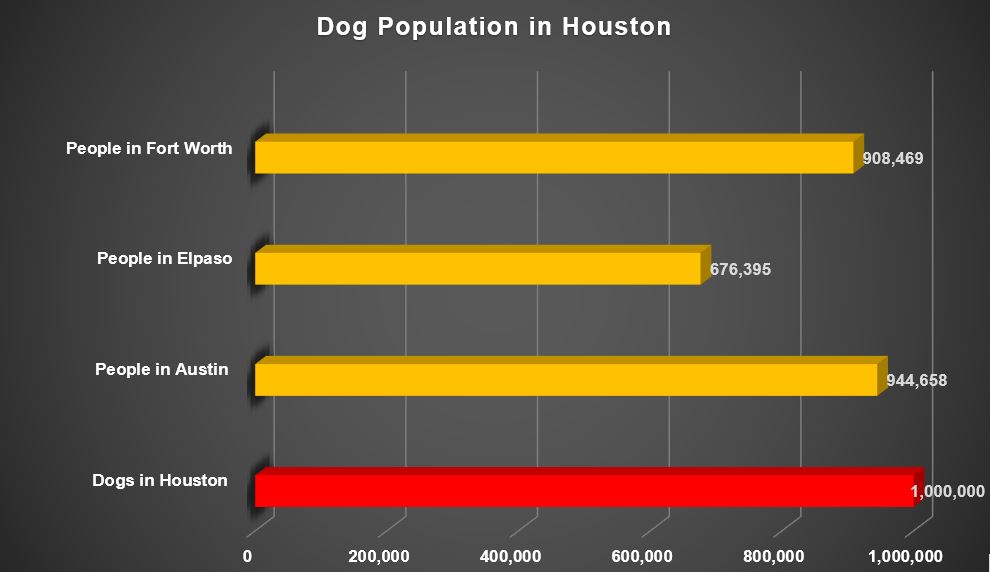
by: Richard C. Vara
Stray cats are also an issue in Houston, and there is not a good estimate of their population. Cats breed rapidly and are capable of producing 1-8 kittens a liter. They can have 2-3 liters per year. That’s roughly 24 kittens a year per cat. In a female cat’s lifetime, she can produce nearly 100 kittens. This ability to reproduce so rapidly makes it almost impossible to guesstimate their total population size in Houston.
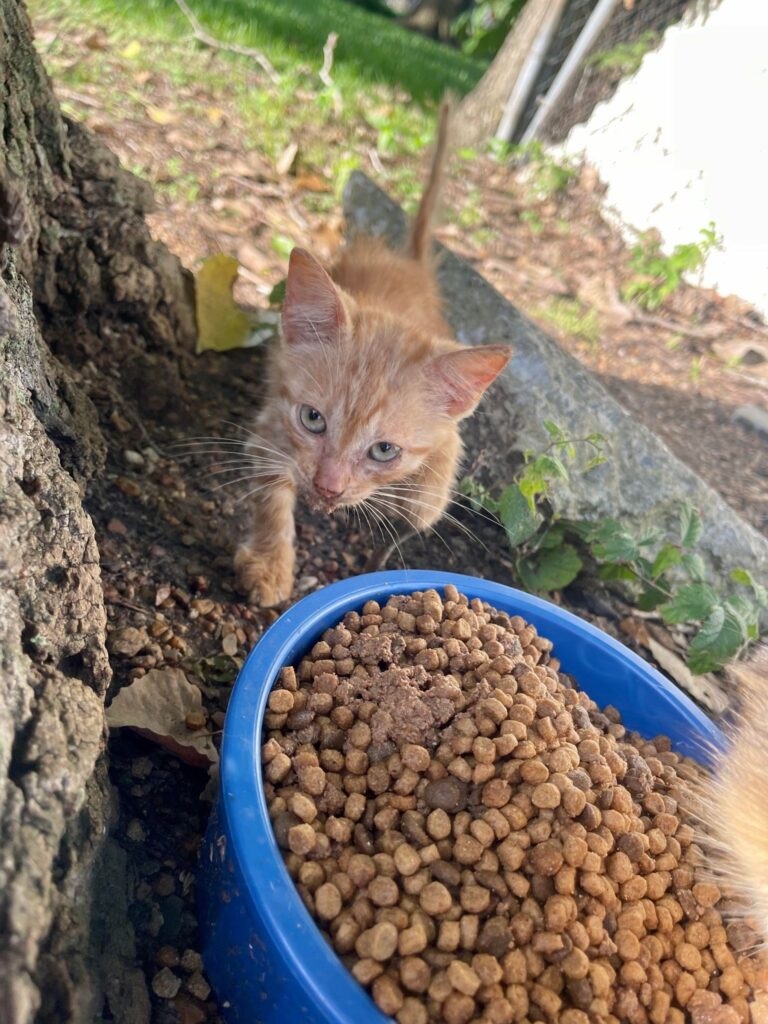
Photo by Gina Damian
With such a massive stray animal population, you might be wondering how did this even happen? There is no one answer as to why Houston has a stray animal crisis. One factor goes back to 2017 and the effects of Hurricane Harvey. With the arrival of one of the largest and worst storms in U.S. history, also came the displacement of thousands of animals.
When Harvey made landfall in Texas, it brought with it massive destruction across the “Lone Star” state. Texas Gulf coast cities such as Galveston, Rockport, and Port Aransas were destroyed by the fury of Harvey. Thousands of families and pets were displaced and came to the closest major city. Houston is an hour drive from Galveston, making it a go-to location for coastal city dwellers during major storms. Another contributing issue is the lack of laws in Texas concerning pets. There are no mandatory spay or neuter laws. The laws in Texas define what spay and neuter are and who can perform surgical and non-surgical sterilization. While Texas does require shelters both public and private to sterilize cats and dogs before being released or adopted, it also allows some interesting exemptions to the law that make it difficult to control the pet population. One of those exemptions is for a municipality that has an ordinance already in place that provides care for such animals,
“Sec. 828.013. EXEMPTIONS. This chapter does not apply to:
(1) a dog or cat that is claimed from a releasing agency by a person who already owns the animal;
(2) a releasing agency located in a municipality that has in effect an ordinance providing standards for dog and cat sterilization that exceed the requirements provided by this chapter;
(3) an institution of higher education that purchases or otherwise procures a dog or cat for the purpose of biomedical research, testing, or teaching; or
(4) a releasing agency located in:
(A) a county with a population of 20,000 or less; or
(B) a municipality with a population of 10,000 or less”.
As you can see, owners of pets are exempt and most cities in Texas are exempt due to large or low populations. In addition, most cities in Texas such as Houston, Dallas, and San Antonio have ordinances that permit them to be exempt from the law. There are very few cities in Texas that have mandatory spay and neuter laws. Dallas and San Angelo are the two largest cities that require the spaying and neutering of pets; however, this does not affect Houston. So, how is the “Bayou City” feeling about this potential practice for controlling the animal population? According to a 2018 KHOU-11 news report by Matt Dougherty, Houston area experts say,
“Spay and neuter ordinances do not work”. The report went on to say,
“’It is time to realize that animal welfare and social welfare are connected,’ said Friends for Life executive director Salise Shuttlesworth. ‘Do we create a penal structure that punishes people who don’t have funds or transportation or time from their job and spend tax money impounding their animals and charging them fees they can’t pay, only to result in killing the unclaimed?’”
In the same report, BARC the City of Houston Animal Control had this to say about spay and neutering,
“Spay and neuter experts say services are accessible and offered free, or at a reduced cost.
‘We can have hundreds of people that show up at 5 a.m. in the morning prepared with their animals,’ said BARC animal shelter division manager Adriane Fadely.
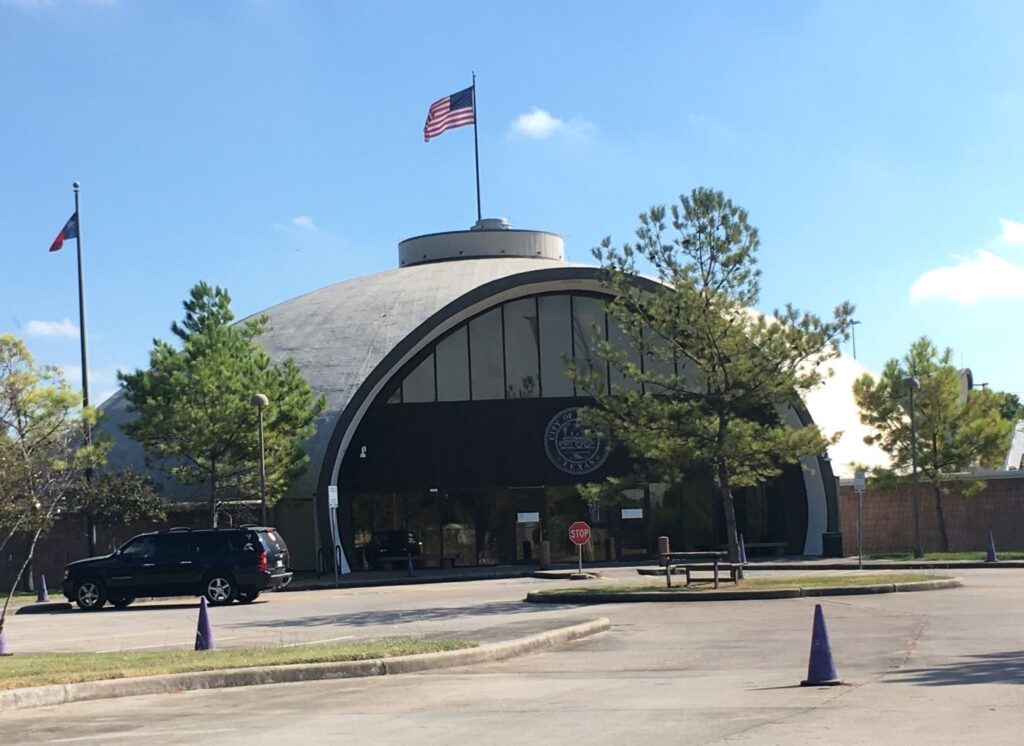
Photo by: Richard C. Vara
BARC says the city does not have nearly enough resources to deal with what would result from a mandatory ordinance either.
‘If we were to provide services to all of our constituents throughout the city, we wouldn’t be able to keep up with the influx of animals that would arrive at our doors,’ Fadely said. ‘So, we wouldn’t be able to mandate it or enforce that law.’” The report stated.
It is strange to hear the city of Houston state that mandatory spay and neutering does not work. Four hours away from Houston is the City of Dallas. Well known for its namesake soap opera “Dallas” it also happens to be the third largest city in the “Lone Star” state. There has always been a rivalry between Houston and Dallas. Both cities have well known NFL and NBA teams. Both cities are also home to major universities and fortune 500 companies. However, in the grander scheme of things Dallas has something that Houston does not. The City of Dallas is one of the few cities in Texas that has mandatory spay and neuter laws. In a 2016 L.A. Times article, it was reported that Dallas had an estimated 9,000 stray animals living on the streets.
After enacting the mandatory spay and neuter law, the numbers have lowered according to Marlo Clingman, the Public Information Coordinator for the City of Dallas,
“We’re at about a 50 percent plus reduction in loose dogs in the 23 southern Dallas zip codes studied that the 8,700 total in 2016 demonstrated.” Mrs. Clingman went on to say,
“We have made progress in Dallas. It is slow but it is progress. The mandatory spay and neuter laws help.” Mrs. Clingman said.
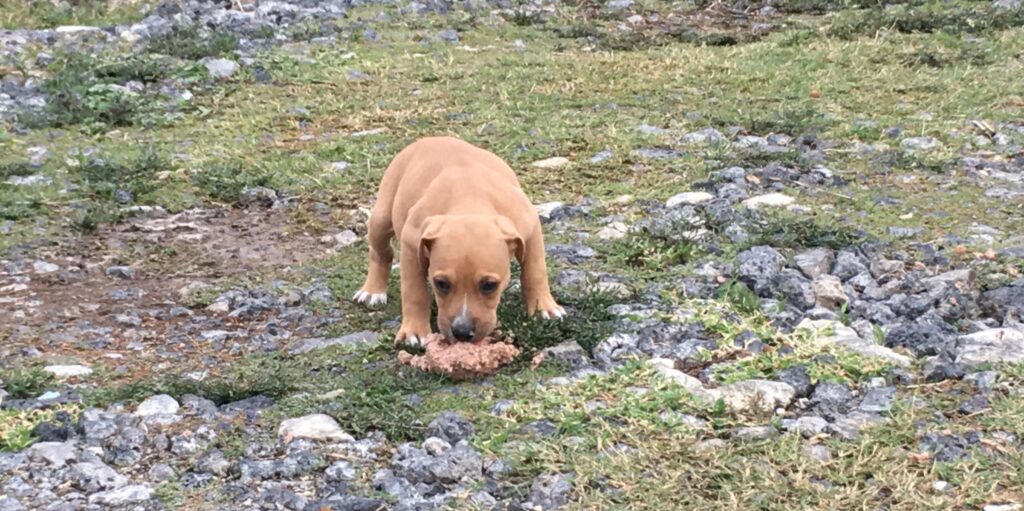
Photo by: Richard C. Vara
Multiple people have mentioned that another contributing issue is that there are no dog or cat breeding laws in Texas. This claim has contributed to the growth of the stray animal population in Houston; however, it is not completely true. Several veterinarians and rescue organizations did mention that backyard breeding is an issue and does contribute to the growth of the stray animal population. It needs to be made clear that backyard breeding is the unlicensed and illegal breeding of dogs and cats in Texas and is punishable,
“Persons who operate without a license may be subject to enforcement actions, including administrative penalties and sanctions in an amount up to $5,000 per day for each violation” according to the “Texas Department of Licensing and Regulation” (TDLR) website.
It also needs to be mentioned that there are only two rules to becoming a licensed breeder in Texas,
“You possess 11 or more adult female dogs and/or cats that are capable of reproduction.
Within one calendar year, you sell, exchange, or offer to sell or exchange at least 20 dogs and/or cats”, according to the TDLR website.
The application fee is $300 for 11-25 cats or dogs or $500 for 26 or more cats and dogs. It also mentions how you can be exempted from the license if you are breeding dogs for hunting, herding livestock, and competing in field trials. This means there are laws in Texas for breeding, just a lack of well-defined laws and regulations for breeding dogs and cats in the “Lone Star” state.
There is no one answer as to why Houston has a stray animal crisis. Natural disasters, backyard breeding, and the lack of laws and regulations along with the lack of local resources are just a few contributors to this situation. Lack of education and owner responsibility is also a big factor in this crisis. People’s lack of responsibility seems to play a bigger factor in the issue at hand. On any given day you can find a pet that has been abandoned on the streets. Lili White, who mostly specializes in cat rescues, deals with a lot of pets that have been dumped on the side of the road by callous owners. On Jan. 31, 2023, an unidentified person left a cage filled with kittens out in the rain with no food or water. The temperature was 38 degrees that morning. Mrs. White went out searching for kittens on a cold and grey Houston day,
“This is ridiculous!… People left them in the cold in the rain, mamma, and babies, soaking wet in this freezing weather”, Mrs. White exclaimed.
Mrs. White is at capacity at her home caring for cats and cannot take them in anymore at this time. She currently has 24 cats in her care of which five are her own fur babies. Last month she had 40 cats in her care. Regardless of capacity, Mrs. White’s bleeding heart and compassion still lead her out in the cold searching for them in the rain. She is determined to get them into some kind of foster care. A friend of hers joins in the search trying to locate the kittens. The person who posted the S.O.S call on Facebook only posted the street name and not the address. Adding more stress to an already frustrating situation. This is a case of people meaning well but not thinking the situation through. Unfortunately, after hours of searching the kittens could not be located.
A month ago, Mrs. White was contacted about a box filled with puppies that had been left on the corner of 5880 W. Gulf Bank Rd. A friend of Mrs. White’s was able to take the puppies into her home and was fortunate enough to find a rescue that was able to adopt the puppies out to forever homes.
Video created by: Ana M. Rivera. Edited by: Richard C. Vara
One of the founding members of the “Empty Shelter Project,” (E.S.P) Dr. Sharron Anderson V.M.D., has been practicing veterinary medicine for 30 years and has some insight as to other reasons why Houston is facing this crisis,
“I think a lot of it has to do with our climate. Up north the animals don’t survive during the winter but here they flourish”, Dr. Anderson went on to say,
“The cost of it (spaying and neutering) is expensive,” Dr. Anderson said.
According to Sammie Jo Garza, one of the medical staff members and a volunteer assisting in the surgery at an E.S.P. event had this to say about the cost of having your pet spayed or neutered at a private clinic,
“The cost could be anywhere from $500 – $900 depending on the size of the dog.” Mrs. Garza said.
With the rising cost of living in the U.S. going up due to inflation rates and the demand for gas driving the cost up, having your pet spayed or neutered may be more of a luxury item than a necessity for some households.
Dr. Henderson V.M.D. talked about how socioeconomics has played a factor in the situation.
“A lot of people end up having to surrender their pets to shelters because they do not have stable housing or are unable to afford basic needs for themselves, or get evicted or have to move into a senior home where they don’t take animals and those animals end up in shelters which drive up the burden that we have up.” Dr. Henderson said.
Video by: Richard C. Vara
Regardless of socioeconomic burdens, the Acevedos were spending $700 a month buying dog food to help save some of these severely malnourished animals. With a few donations and reducing the purchase of wet food, they have brought the cost down to $400 a month. Mrs. Acevedo saw a need and does what she can to help,
“I got into this because I would see dogs starving. I would see their ribs. I know I can’t save them all, but I can help some in my community.” Mrs. Acevedo said.
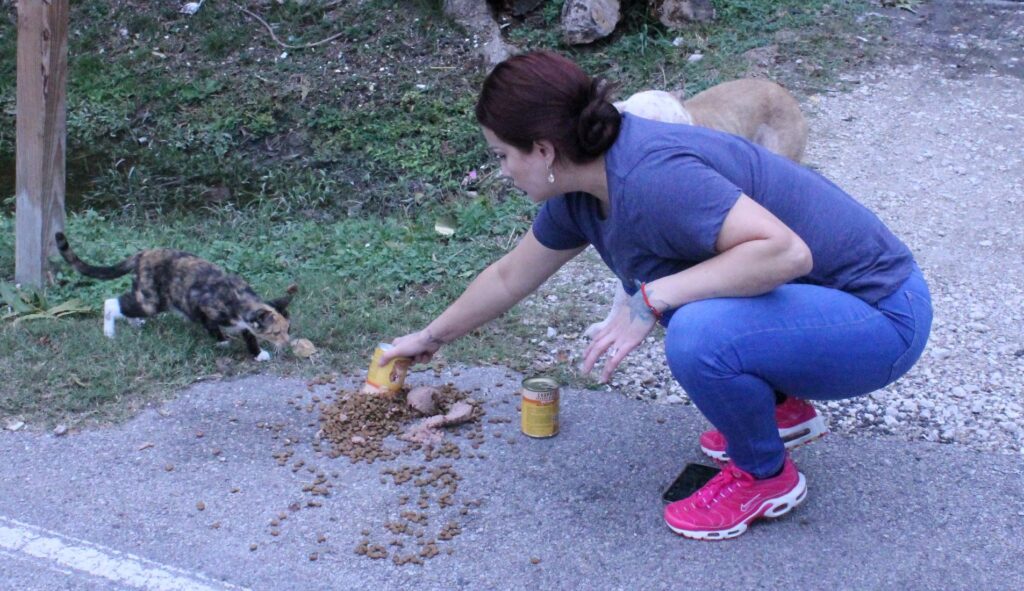
Photo & Video by: Richard C. Vara
Click the photo for the video
She and her husband work tirelessly to help alleviate the issue of the animal crisis. Not only are they sacrificing from their own pockets to buy food and gas, but Mrs. Acevedo also does a lot of outreach in the community of Cloverleaf. She reaches out to people and informs them on how they can receive free spay and neuter services through the “Empty Shelter Project,” an organization for which she advocates,
“Most people here do not believe in spaying or neutering their pets. They don’t understand the benefits of it.” Mrs. Acevedo said.
Mrs. Acevedo stops what she is saying to call back a large group of dogs that she was feeding. The dogs running loose in the street were trying to chase a large silver Chevy truck. The dogs then turned their attention to two men who were walking by, and the pack started to give chase after them. The dogs stopped after one of the men yelled at the pack. The men were lucky that the dogs backed away. In 2022, three people died due to dog pack attacks in Houston.
In the fall of 2022, a Houston Police Officer was attacked by dogs when responding to an aggressive dog report. In yet another attack, according to a Fox 26 news report by Damali Keith, on Aug. 26, 2022, a man was found dead in the street after he had been attacked by a dog. A month before that a 51-year-old man died after he was attacked by three dogs. With dog attacks and people being killed by the attacks, you would ask what is being done to resolve this situation. I reached out to the City of Houston several times to ask about what steps they are taking to resolve this issue. It is important to note that people are not the only ones who are in danger. The animals themselves face dangers from other animals and people. The worst dangers come from humans.
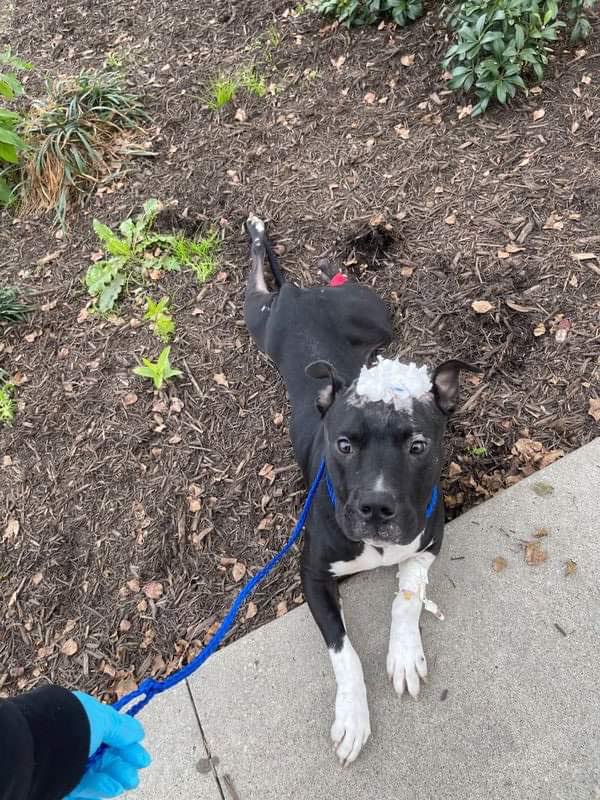
Photo provided by: Kosandra Ramirez
Kosandra Ramirez is a board member of the organization “ThisIsHouston.” She is also the medical coordinator for the Cleveland Clinic. Because of her work in animal rescue, she is forced to bear witness to the darker side of animal cruelty. Mrs. Ramirez recalled the story of Mac the puppy. In November 2022 a call came in to “ThisIsHouston” about a severely injured male puppy that was abandoned in a parking lot. The poor puppy could barely walk and had cotton-like trash glued to his head. When the cotton was removed it was discovered that this adorable loving pup was in a lot of trouble. Someone had scalped this innocent puppy and left him out in the elements. It was never discovered who committed this horrible act of cruelty towards a defenseless puppy. This is one of the many dangers stray animals face in the city of Houston. No one is looking for them and it makes them easy targets for random acts of cruelty.

The puppy was then given the name Mac and he was going to require several costly surgeries to give him a fighting chance at life. The entire top part of his scalp was sliced off and the mixture of glue and cotton-like trash had made things worse. The veterinarians determined that Mac’s injuries were more than likely man-made. Mrs. Ramirez and the good people at “ThisIsHouston” took charge of the situation and made sure Mac received the medical care he needed to have a fighting chance. Mac had to undergo several surgeries and received specialized care for three months. The medical care Mac needed cost around $35,000. Mac has fully recovered from his traumatic injuries and is now playing with toys and running around in the yard of his foster parent.
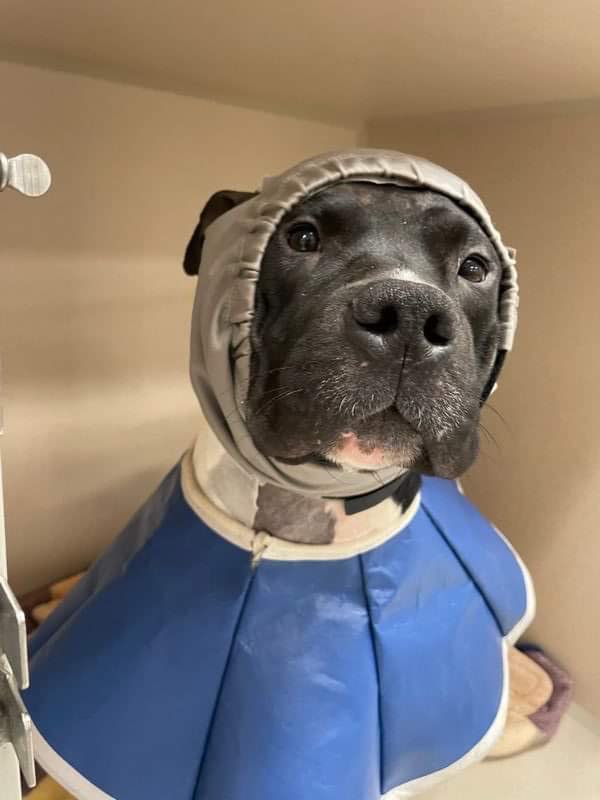
Photo provided by: Kosandra Ramirez
Not all dogs or cats get to live out this kind of happy ending. Sometimes they pay the ultimate price for being abandoned by people or simply getting lost. Mrs. Ramirez asked me to share a horrible distress call that came out of Rio Grande, Texas to anyone in the Houston animal rescue community who could take in a group of stray dogs. A group of men had been going in and out of a field behind a store. It was later discovered that the men had been decapitating and cutting off the paws of puppies in the field.

The men were never caught and it is unclear if a police report was ever made with the Rio Grande Police Department (R.G.P.D.). However, pictures were taken as evidence, and an S.O.S. message was sent out to animal rescue groups on social media platforms such as Facebook.
Sometimes it is not the predatory dangers of a human being or lack thereof that can cause injury to an innocent stray animal. Sometimes it is just an accident. Take the case of Athena, a case that both Mrs. Acevedo and Mrs. Ramirez were involved. Athena is a beautiful silver and white Pitbull that was lost or abandoned in an industrial part of the city that is also common grounds for abandoning animals. An urgent call had gone out to rescuers about a dog who was rumored to have been chained to a railroad track and was struck by a train. The impact from the train tore off Athena’s front two legs. Mrs. Acevedo was the rescuer who arrived at the scene,
“That was the most shocking! I did not know I could deal with an emergency situation like that. We tracked her down, we saw the nub marks of blood.”
Mrs. Acevedo went on to say,
“We followed the marks, it went into this property, it (Athena) was under some trailer.” Mrs. Acevedo said.

When asked if Athena was chained to the track Mrs. Acevedo had this to say,
“There was no evidence of that. We believe she (Athena) was trying to cross or something, there was no evidence at all.” Mrs. Acevedo said.
Mrs. Acevedo then took Athena to a veterinarian hospital on behalf of “ThisIsHouston.” Mrs. Ramirez went to the hospital to evaluate Athena’s condition and make the difficult decision of whether Athena could be saved or not. Whatever Mrs. Ramirez ultimately decided is what the organization would stand by.
“She is laying on the floor and she lifts her head up and all you see is her tail wagging…” Mrs. Ramirez went on to say,
“There is no possible way we can put her down. We need to fight for her.” Mrs. Ramirez said.
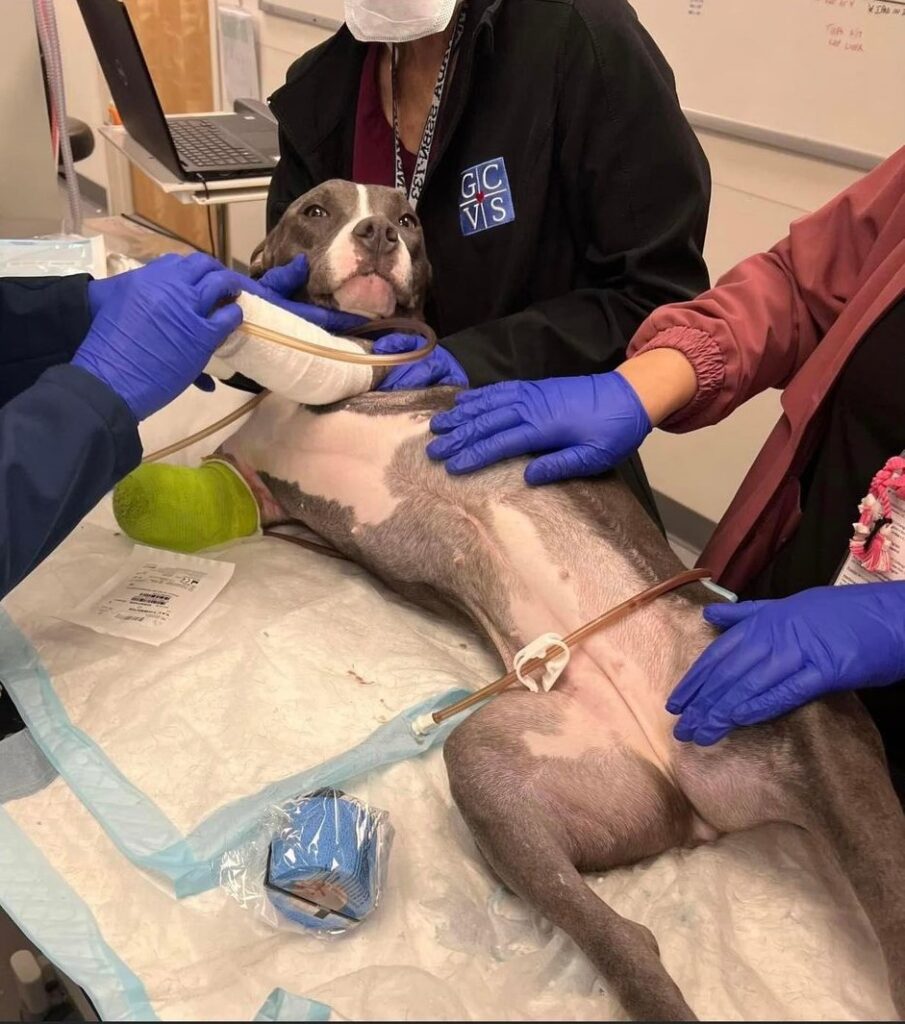
Photo provided by: Kosandra Ramirez
It cost more than $30,000 to treat Athena. Mrs. Ramirez points out that the care that has been provided to dogs like Athena and Mac comes from donations. It also comes from amazing people such as Mrs. Ramirez and Mrs. Acevedo who are on the front lines of this situation feeding, transporting, rescuing, and organizing events to combat the stray animal crisis in Houston. Mrs. Ramirez could very well be responsible for saving the lives of 300-plus dogs in the Houston area.
BARC the City of Houston Animal Contol did not respond to my request for an interview. However, last year the City of Houston did pass an ordinance that requires all pet owners to have their pets microchipped. This is meant to make it easier to reunite lost pets with their owners and to keep them out of crowded shelters. The new ordinance took effect on Feb. 1, 2023. Pet owners who do not have their pets chipped can face a $500.00 fine.
In the grand scheme of things, it seems like the good citizens of Houston and surrounding areas are leading the charge to get control of this situation. Mrs. Acevedo has made it her life mission to help as many dogs as possible. One of the many ways she helps is by helping to organize community spay and neuter events. On Dec 3, 2022, Mrs. Acevedo and a massive team of other organizations such as the “Empty Shelter Project” and “Canie Angels” transformed the “Leon Z. Grayson Community Center” into one of the largest “M.A.S.H.,” or Mobile Army Shack Hospital, units for dogs and cats in the Houston area.
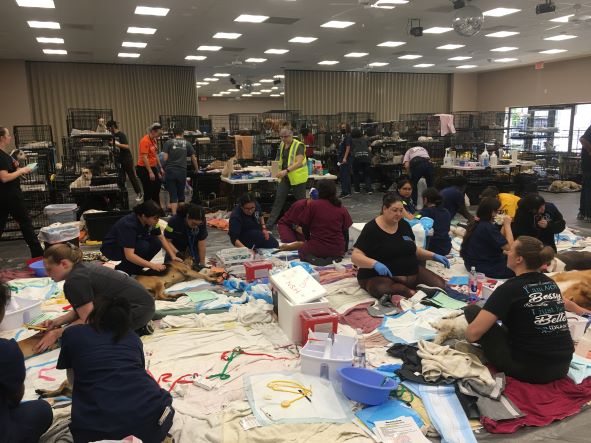
Photo by: Richard C. Vara
Veterinarians from all over the nation were flown in to spay and neuter 426 dogs and cats in one day. Not only were the dogs and cats surgically sterilized, but they were also vaccinated and microchipped for free.
Dr. Henderson V.M.D. drove to Houston from Austin to volunteer at this event. She was on her 18th surgery of the day since she started at 9 a.m.,
“Events like this really help. The goal for us today is to do 400 surgeries. That is 400 animals that will be able to get free spay and neuter services.” She went on to say,
“There is a huge need for this service and we are really happy to be here today to provide that to the Houston area.” Dr. Henderson said.
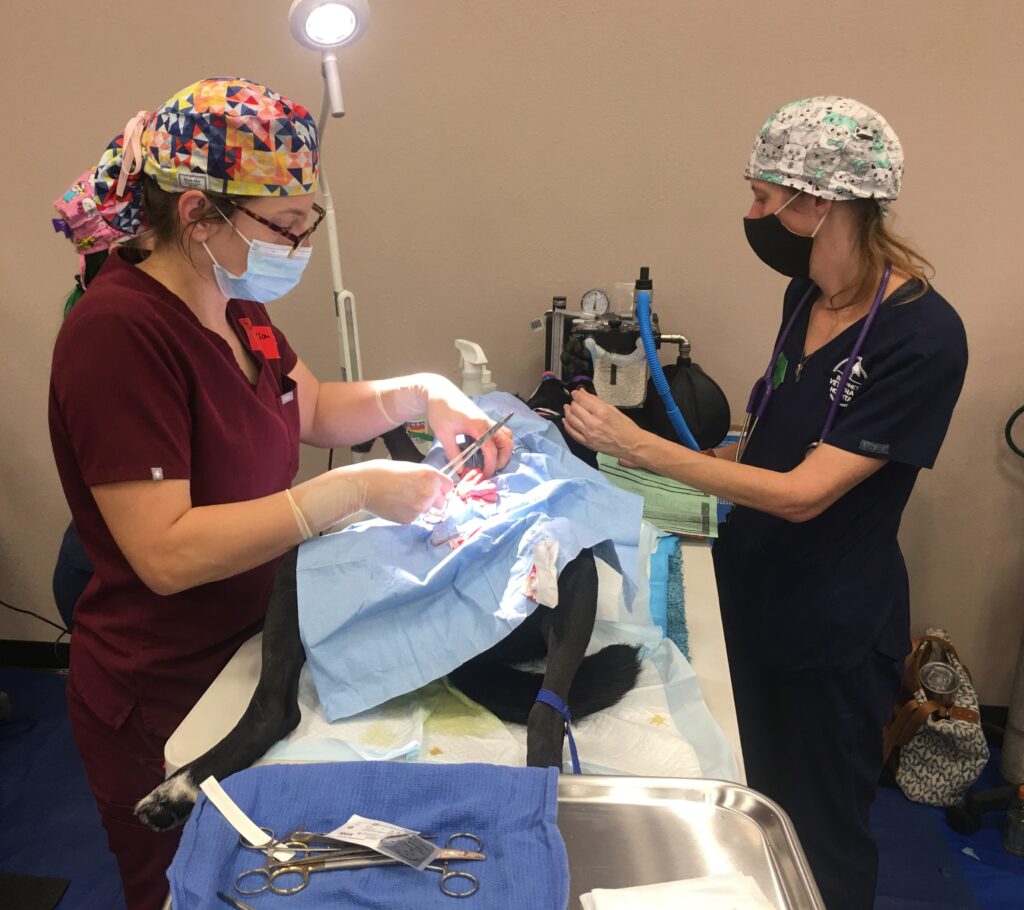
Photo by: Richard C. Vara
Dr. Henderson also mentioned a few things that citizens can do to help fight the animal crisis in Houston. Getting your pet spayed and neutered is one of the ways people can help. Also volunteering at animal shelters can help alleviate the burden that shelters are facing. She also mentions one piece of advice that a lot of people do not consider,
“Buy from a reputable breeder! It is very important that the breeder is breeding responsibly.” Dr. Heanderson said.
Miller Freedman is one of the founding members of the E.S.P. and tells us the E.S.P. has probably spayed and neutered several thousand cats and dogs over the year,
“This is not a situation we can adopt our way out of. The only way we can deal with the animal crisis here in Houston is to go directly to the source. Which is spay and neuter.” Freeman said.
Mr. Freeman also shared the cost to host such an event.
“It’s $40,000 per event and we will hold five events out of the year.” Mr. Freeman said.
That comes to a total of $200,000 a year to help alleviate the issues that Houston and its citizens are dealing with. It almost seems like everyone from various communities is helping out. Students from “Texas A&M’s School of Veterinarian Medicine & Bioscience” are on hand to help vaccinate and assist in the surgeries. Even high school students from the “Alief Veterinary Science Program” are also helping to take vitals, vaccinate, and microchip the animals as they come out of surgery.
Stacy Portillo is a senior who will be graduating in 2023. She wants to pursue her dream and become an aquatic veterinarian. Ms. Portillo is giving up her Saturday, not only to earn hours to become a certified veterinary assistant, but she is also here helping to make a difference in the crisis that Houston is facing,
“It’s sad. We help as many dogs as we can and there is not too much we can do…” Mrs. Portillo said.
Video by: Richard C. Vara
Under the supervision of their teacher Erica Santillan, they are not only helping put a dent in the crisis, but they are also working on earning a certificate to become a veterinary assistant. Whether they realize it or not, they are doing more than they know to help fix a major issue in the community.
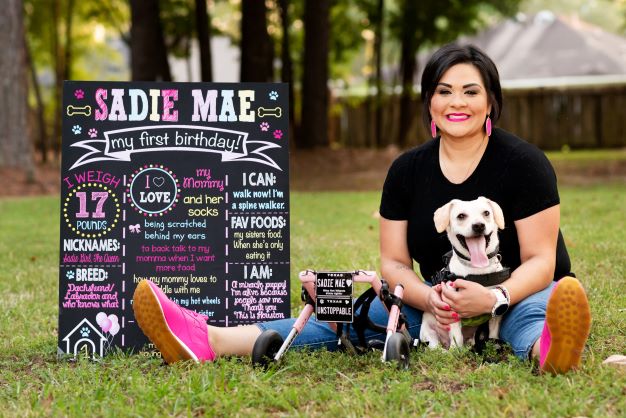
Photo provided by: Kosandra Ramirez
Mrs. Ramirez also does her part to help fight this crisis. She also sets up massive spay and neuter events in her community to help combat the stray animal crisis. In one event 131 pets were spayed and neutered. She also has six fur babies of her own, one of which is a special needs fur baby named Sadie. With all of this and working a full-time job, Mrs. Ramirez still finds time to go out of her way to rescue animals that are in need. She recently saved a senior dog she named Mr. Rogers from living in deplorable conditions. Mr. Rogers is partly blind and deaf. He was starved and had not been bathed in some time.
“I cried, I couldn’t just leave him there in those conditions.”Mrs. Ramirez exclaimed.
Mrs. Ramirez took Mr. Rogers home, bathed him, fed him, and got him the medical attention he needed. The organization “Hoof and Paw” stepped in to help with the medical expenses as Mrs. Ramirez looks after him as his foster mother. Mr. Rogers is adjusting to being taken care of and loved. Mr. Rogers has the habit of trying to crawl under cars because he has been living under them for so long. He has discovered the comforts of Mrs. Ramirez’s couch and does not know how to eat or react to a pup cup from the coffee shop.

Photo provided by: Kosandra Ramirez
Mr. Rogers will have some life adjustments to make, but with the care and love Mrs. Ramirez provides to him, he will make it through. Mrs. Ramirez will also have to make some life adjustments. This will make seven fur babies living in the same house. That also means the expenses of feeding and caring for Mr. Rogers, including driving him to and from vet appointments, will be a burden that she takes on. The one thing that can be said is that Mrs. Ramirez has a loving heart that drives her to make life better for canines across the Houston area.
Not everyone has the good fortune to be connected to rescue organizations for assistance. One elderly woman living in the Northside of Houston gets up every morning and feeds the neighborhood stray cats and chickens. Houston, a booming metropolis, has stray chickens running loose in the streets. We will not identify the woman because the City of Houston will ticket you for feeding stray animals. An ordeal that Mrs. Acevedo had to go through. Much like other animal populations, this issue started with chickens escaping their enclosure or being left behind when their owners moved away. Either way, this kind-hearted elderly woman gives her time and part of her income to feed these forgotten or abandoned animals. You can only imagine how hungry a cat and chicken must be to share the same food.
Volunteers such as Mrs. Acevedo and Ramirez are the ones who are truly leading the efforts in getting control of the stray animal crisis. Their efforts are what have been making a difference in the city of Houston. However, this difference comes at a cost to the volunteers, and it’s not always financial. In many cases, it is at a much higher emotional cost.
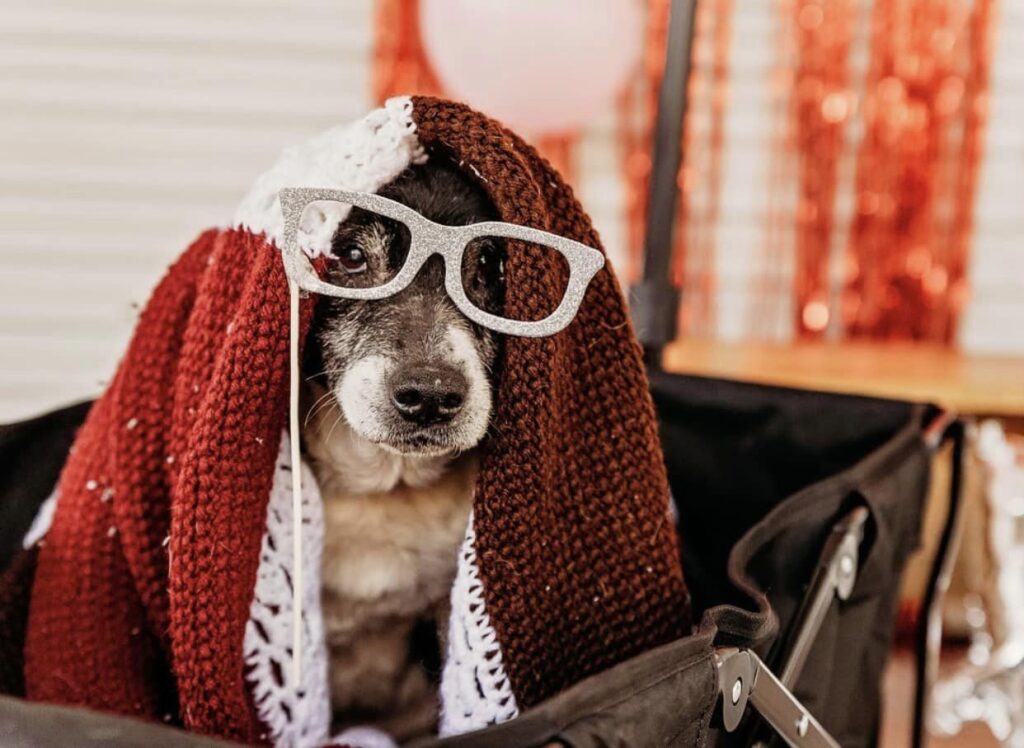
Photo provided by: Kosandra Ramirez
Sadly on Feb. 12, 2023, Mr. Rogers passed away due to a collapsed trachea, a common occurrence in elderly dogs. Mr. Rogers lived a tough life living in slum-like conditions and sleeping under parked cars. Mrs. Ramirez saved Mr. Rogers from his life of squaller. She opened her home to him and showed him love, kindness, and compassion. Since she rescued him a little over a month ago Mr. Rogers was able to experience what it was like to feel loved and cared for before his passing. He even knew the comforts of sleeping in a warm bed and the simple joy of discovering the comforting embrace of a big comfy couch. Something he would have never experienced if it were not for Mrs. Ramirez rescuing him. More than likely, he would have died a painful death. Choking to death while living under a car and by himself. No one would have been there to comfort him or take him to a clinic.
On the day Mr. Rogers got sick Mrs. Ramirez took him to a clinic and was with him right up to the moment when they had to put him to sleep. Even though Mr. Rogers was only in her life for a short time she loved him like her own and cried for several days after his passing. It is a high cost to pay for a privet citizen who opens their heart, home, and wallet to make a difference in the life of a neglected fur baby.
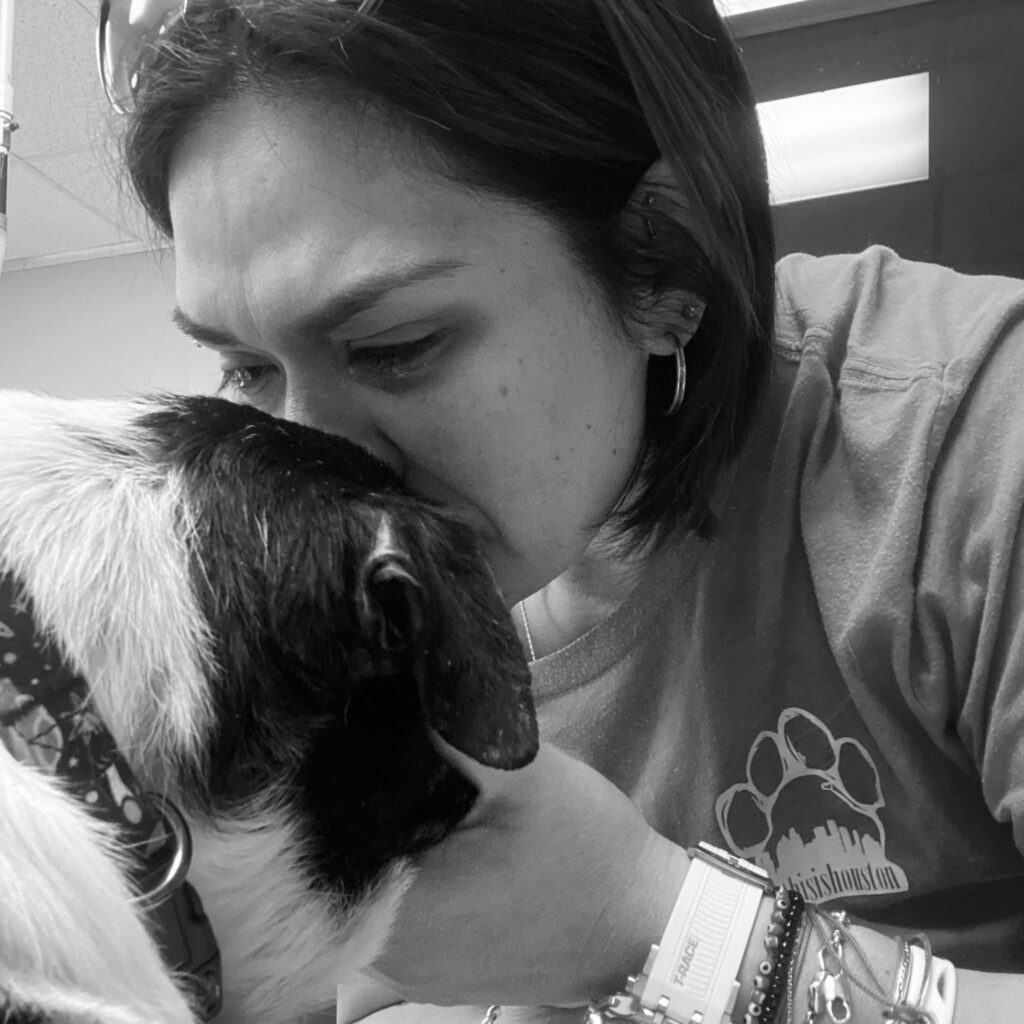
Photo provided by: Kosandra Ramirez
Sometimes the cost of this emotional toll is too much to bear. Rachel Limas is a former animal rescuer. She used to be heavily involved in rescuing stray animals in the Houston area, but the demand for rescues became too much. The non-stop calls and constant demand to help animals in horrible conditions took a toll on her mental health. Not only was she saving animals at all hours of the day and night, she is also a small business owner and a single mother of four. On top of that, she has two dogs of her own. She was forced to make the hard choice of giving up rescue work when she realized it was affecting her family.
Mrs. Limas recalled an event where she was called out to assist a dog catcher who was trying to separate a larger dog that was attacking a smaller dog. It was a difficult situation for her. Someone had to distract the larger dog, and as the dog was being distracted she had to rush under a car to retrieve the smaller injured dog. Once she was able to retrieve the smaller dog she rushed the dog to the vet, but its injuries were too severe. It was recommended to put the dog to sleep.
“Here I am with a dog that is not even mine and I have to decide to put it down. All because two people couldn’t keep their dogs in their yard.” Mrs. Limas added,
“It was the hardest decision I had to make. I didn’t know I could make that decision.” Mr. Limas said.
As she thought more of the tragic events, she remembers how people were just standing around and no one was doing anything. She had to take a break after that sad event to process what happened and take a moment for herself. Even though she was on a short break, the demand for her services was non-stop,
“I was drowning in it. I couldn’t turn off my regular life versus Rachel the dog rescuer. I couldn’t get away from it. The constant messages and need.” Mrs. Limas went on to say,
“It was a lot, I had to turn off my social media. People could not contact me. I had to turn away completely because there was no in-between.” Mrs. Limas said.
Mrs. Limas continued to rescue dogs for several years before she decided to leave rescue work. However, it was not all emotionally stressful and bad. Some of the rewards of being in the animal rescue was being able to see the impact that she had on saving a dog’s life. She would receive updates and Christmas cards about the dogs she helped to save. Many of the dogs Mrs. Limas saved found homes in New York and other places up north. She would receive Christmas cards of dogs that were once starved and sick now enjoying their first Christmas in the snow. They are now happy, healthy, and living in a loving forever home. Mrs. Limas will still on occasion pull over and rescue a dog or two from time to time.
There are a lot of good people doing a lot of good acts to help the stray animals in Houston, like husbands and wives who spend their time and money feeding starving animals or teenagers who are helping to vaccinate and microchip people’s pets. All of these actions are wonderful acts of charity and kindness. Yet it is still sad to think that with all these acts of kindness, 1.5 million stray animals will still sleep on the streets at night or go hungry daily. The sad reality of this is that everyday citizens are sacrificing what they have to battle this ongoing situation.
It would be easy to point the finger at local government agencies such as BARC. After all, they receive tax money and have resources that come from the taxes that people pay. It would be easy to look at BARC and ask
“How are you using our money and why are you not doing enough to resolve this problem?”
Perhaps a few of those questions should be asked to BARC and city officials. Is a mandatory microchip law the best solution to the problem? Could more be done on the local government’s part to help lower the number of stray animals on the streets? Perhaps.
Other than displacement from storms, a lot of this seems to be a man-made problem. People who abandon their pets on the street and allow their issues to become someone else’s problem are to blame. People who refuse to spay and neuter their pets could also be part of the issue. The interesting thing about a situation is you can blame anyone. There is always someone you can wag a finger at, like breeders, irresponsible pet owners, government officials, people who know about the situation, and people who don’t know about the situation. The blame game is good for one thing and that is distracting you from asking a more important question. One of the more important questions that need to be asked is whether Houston can get control of a population of 1.5 million stray animals. People’s donations, efforts, and rescue work do help. But with all this, will it reduce the numbers?
Erica Santillan is the Alief I.S.D. Vet Science Teacher and has her own farm with 53 animals. She is also a former employee of BARC. She had this to say about Houston being able to get control of the stray animal crisis,
“Optimistically I want to say yes. Realistically, probably not.” She went on to say,
“It’s a big city and it’s going to take a lot more from the public to do what needs to be done. But this helps.” Mrs. Santillan said.
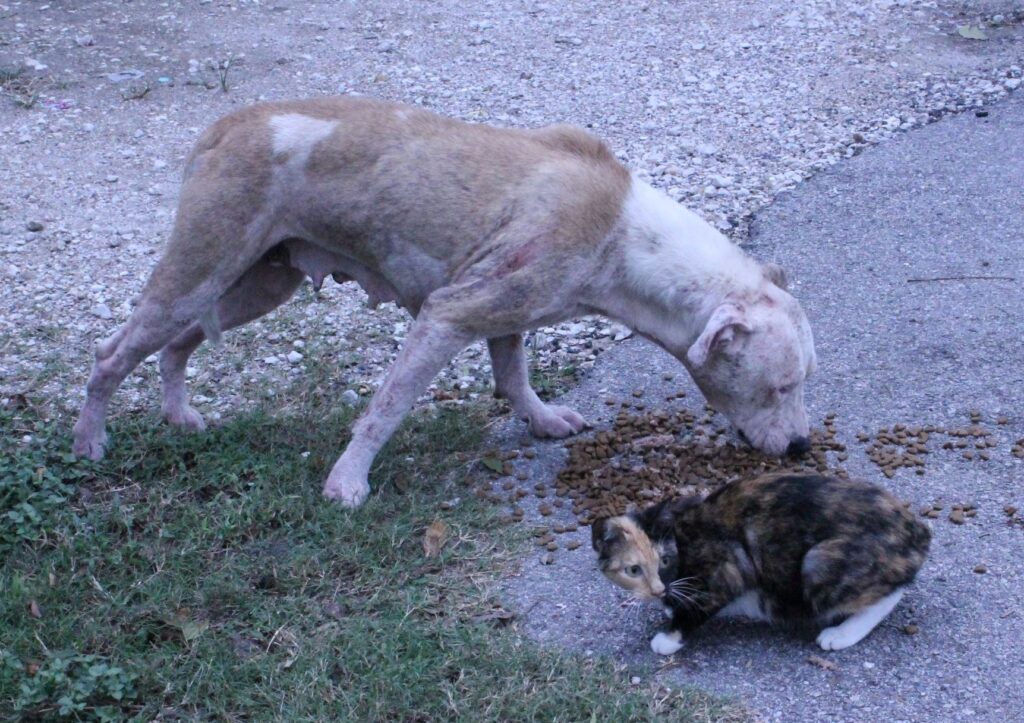
Photo by: Richard C. Vara

